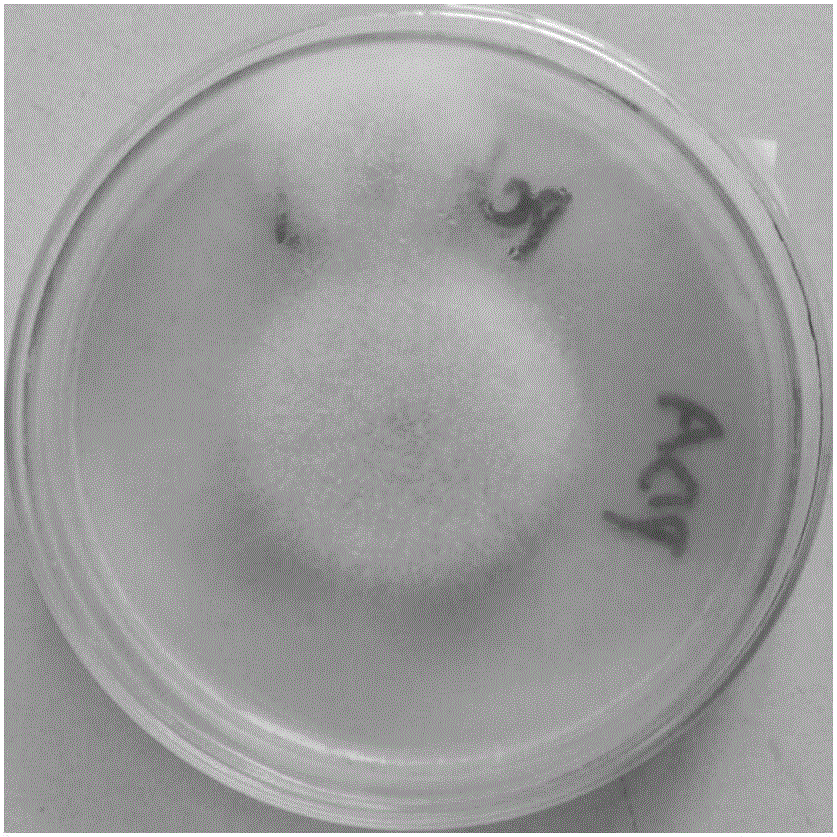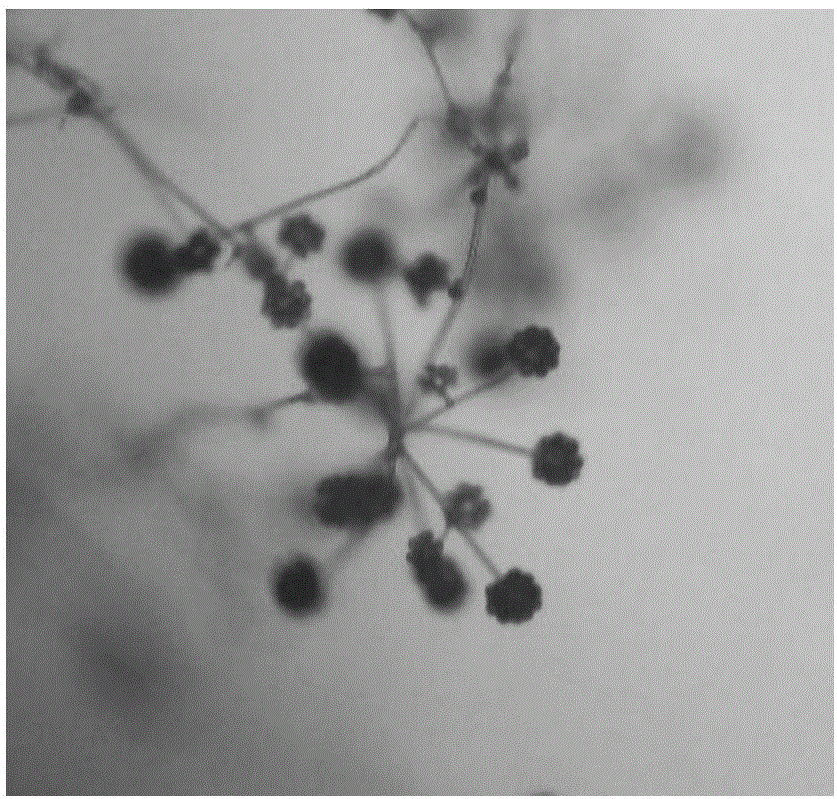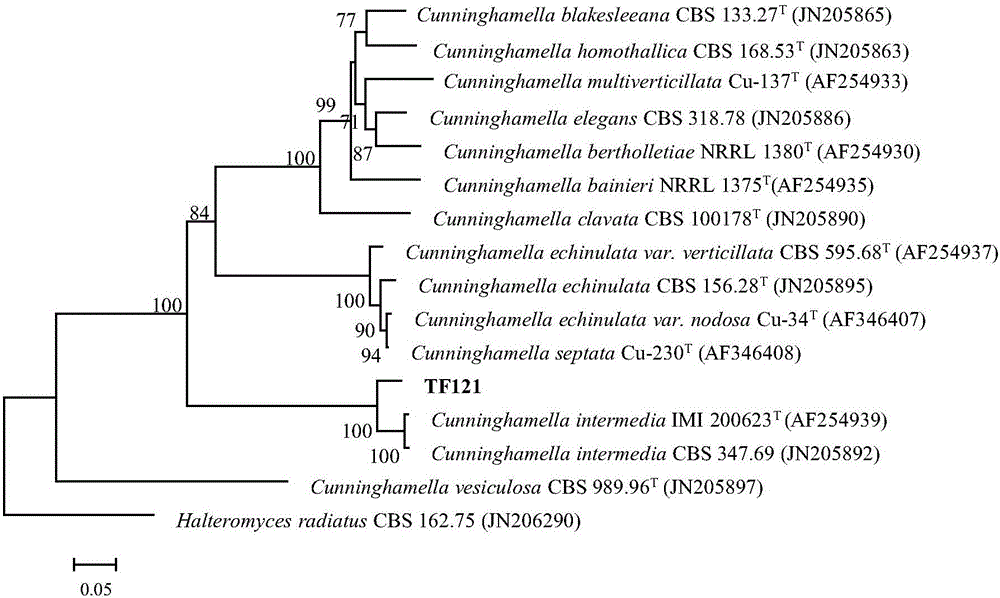Heat-resistant fungus new species and application thereof in microbial fertilizer
A microbial fertilizer and microbial agent technology, applied to filamentous fungi and their application in the preparation of microbial fertilizers, microbial strains and their application in the agricultural field, to achieve high enzyme activity, good thermal stability, and simple cultivation conditions
- Summary
- Abstract
- Description
- Claims
- Application Information
AI Technical Summary
Problems solved by technology
Method used
Image
Examples
Embodiment 1
[0034] Example 1: Isolation, screening and identification of Cunninghamella sp. TF121
[0035] 1. Separation: It was obtained from the natural composting process samples of sheep manure around sheep pens in Turpan, Xinjiang. The sample adopts the gradient dilution method, weighs 10g of the irradiated soil sample, puts it in 90ml of sterile physiological saline, activates it at 28°C-32°C for 30min-2h, then performs gradient dilution, and spreads it on a PDA medium plate for cultivation.
[0036] 2. Purification: after the growth of fungal colonies, pick out colonies of different shapes, sizes, colors, etc., and inoculate them on corresponding plates, and purify and cultivate them at 40°C-60°C, preferably at 55°C until there are no foreign colonies. Strains are preferred.
[0037] 3. Classification and identification: By observing the colony shape and physiological and biochemical characteristics, the total DNA of the strain TF121 was extracted, and the fungal ITS PCR amplifica...
Embodiment 2
[0044] Example 2: Analysis of Cunninghamella sp. TF121 CGMCC No.12624 Functional Enzyme
[0045] Using the transparent circle method, plant Cunninghamella sp. TF121 CGMCC No.12624 on the cellulase screening medium ((NH 4 ) 2 SO4 2.0g, MgSO 4 0.5g, KH 2 PO 4 1.0g, CMC-Na 2.0g, Congo red 0.4g, agar 15.0g, distilled water 1L, pH natural), amylase screening medium (soluble starch 20.0g, KCl 0.5g, NaNO 3 2.0g, KH 2 PO 4 1.0g, MgSO 4 ·7H 2 O 0.5g, agar 15.0g, distilled water 1L, pH 6.5), lipase screening medium (KH 2 PO4 0.2g, MgSO 4 0.05g, PVA emulsion 2.0mL, yeast powder 0.2g, peptone 1.0g, agar 1.7g, distilled water 1L, pH 6.5. Sterilize and cool at 50°C, add 10mL0.2% rhodamine B solution), protease screening medium (peptone 10.0g, glucose 1.0g, CaCl 2 0.1g, tyrosine 0.1g, casein 5.0g, agar 15.0g, distilled water 1L, pH 6.5, chitosan enzyme screening medium (chitosan 10.0g, (NH 4 ) 2 SO 4 2.5g, MgSO 4 ·7H 2 O 0.25g, K 2 HPO 4 0.02g, CaCO 3 6.0g, agar 20.0, pH 6.0...
Embodiment 3
[0049] Example 3: Determination of parasitism of root-knot nematode eggs by heat-resistant Cunninghamella sp. TF121 CGMCC No.12624
[0050] The isolated and purified Cunninghamella sp. TF121 CGMCC No.12624 was cultured on the slant of PDA medium for 3 days, and then 5 mL of sterile water was added to the slant test tube, shaken vigorously, and then filtered with double-layer sterile gauze. The filtrate was prepared by appropriate dilution to contain 10 6 A spore suspension was used for later use.
[0051] Select a glass petri dish with good light transmittance, add sterilized 0.1% chloramphenicol water agar (distilled water 1L, agar 10g, add chloramphenicol after sterilization to a final concentration of 0.1%), and make a thickness of about 1.5mm Flat TLC. Add 10 μL of spore suspension of Cunninghamella sp. TF121 CGMCC No.12624 dropwise under sterile conditions on the water agar plate. Root-knot nematode egg suspension from the source, the petri dish was sealed with parafil...
PUM
 Login to View More
Login to View More Abstract
Description
Claims
Application Information
 Login to View More
Login to View More - R&D
- Intellectual Property
- Life Sciences
- Materials
- Tech Scout
- Unparalleled Data Quality
- Higher Quality Content
- 60% Fewer Hallucinations
Browse by: Latest US Patents, China's latest patents, Technical Efficacy Thesaurus, Application Domain, Technology Topic, Popular Technical Reports.
© 2025 PatSnap. All rights reserved.Legal|Privacy policy|Modern Slavery Act Transparency Statement|Sitemap|About US| Contact US: help@patsnap.com



